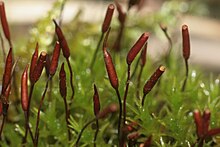Embryophyte
| Land plants Temporal range: (Spores from Dapingian (early Middle Ordovician))
| |
|---|---|
| Scientific classification | |
| Kingdom: | Plantae |
| Clade: | Streptophyta |
| Clade: | Embryophytes Engler, 1892[3][4] |
| Divisions | |
Traditional groups:
| |
| Synonyms | |
The embryophytes (
The embryophytes are informally called "land plants" because they thrive primarily in
Description

The Embryophytes emerged either a half-billion years ago, at some time in the interval between the mid-
On a microscopic level, the cells of charophytes are broadly similar to those of
In common with all groups of multicellular algae they have a life cycle which involves
Embryophytes also differ from algae by having
Evolution
The green algae and land plants form a
Some time during the Ordovician, streptophytes invaded the land and began the evolution of the embryophyte land plants.[28] Present day embryophytes form a clade.[29] Becker and Marin speculate that land plants evolved from streptophytes because living in fresh water pools pre-adapted them to tolerate a range of environmental conditions found on land, such as exposure to rain, tolerance of temperature variation, high levels of ultra-violet light, and seasonal dehydration.[30]
The preponderance of molecular evidence as of 2006 suggested that the groups making up the embryophytes are related as shown in the cladogram below (based on Qiu et al. 2006 with additional names from Crane et al. 2004).[31][32]
| Living embryophytes |
| ||||||||||||||||||||||||||||||||||||
An updated phylogeny of Embryophytes based on the work by Novíkov & Barabaš-Krasni 2015[33] and Hao and Xue 2013[34] with plant taxon authors from Anderson, Anderson & Cleal 2007[35] and some additional clade names.[36] Puttick et al./Nishiyama et al are used for the basal clades.[13][37][38]
|
Paratracheophytes
Lycophytes |
Diversity
Non-vascular land plants
This section needs additional citations for verification. (November 2018) |

The non-vascular land plants, namely the
They are usually studied together because of their many similarities. All three groups share a
Like the vascular plants, they have differentiated stems, and although these are most often no more than a few centimeters tall, they provide mechanical support. Most have leaves, although these typically are one cell thick and lack veins. They lack true roots or any deep anchoring structures. Some species grow a filamentous network of horizontal stems,[clarification needed] but these have a primary function of mechanical attachment rather than extraction of soil nutrients (Palaeos 2008).
Rise of vascular plants

During the Silurian and Devonian periods (around 440 to 360 million years ago), plants evolved which possessed true vascular tissue, including cells with walls strengthened by lignin (tracheids). Some extinct early plants appear to be between the grade of organization of bryophytes and that of true vascular plants (eutracheophytes). Genera such as Horneophyton have water-conducting tissue more like that of mosses, but a different life-cycle in which the sporophyte is more developed than the gametophyte. Genera such as Rhynia have a similar life-cycle but have simple tracheids and so are a kind of vascular plant.[citation needed] It was assumed that the gametophyte dominant phase seen in bryophytes used to be the ancestral condition in terrestrial plants, and that the sporophyte dominant stage in vascular plants was a derived trait. However, the gametophyte and sporophyte stages were probably equally independent from each other, and that the mosses and vascular plants in that case are both derived, and have evolved in opposite directions.[39]
During the Devonian period, vascular plants diversified and spread to many different land environments. In addition to vascular tissues which transport water throughout the body, tracheophytes have an outer layer or cuticle that resists drying out. The sporophyte is the dominant generation, and in modern species develops leaves, stems and roots, while the gametophyte remains very small.
Lycophytes and euphyllophytes

All the vascular plants which disperse through spores were once thought to be related (and were often grouped as 'ferns and allies'). However, recent research suggests that leaves evolved quite separately in two different lineages. The lycophytes or lycopodiophytes – modern clubmosses, spikemosses and quillworts – make up less than 1% of living vascular plants. They have small leaves, often called 'microphylls' or 'lycophylls', which are borne all along the stems in the clubmosses and spikemosses, and which effectively grow from the base, via an intercalary meristem.[40] It is believed that microphylls evolved from outgrowths on stems, such as spines, which later acquired veins (vascular traces).[41]
Although the living lycophytes are all relatively small and inconspicuous plants, more common in the moist tropics than in temperate regions, during the Carboniferous period tree-like lycophytes (such as Lepidodendron) formed huge forests that dominated the landscape.[42]
The euphyllophytes, making up more than 99% of living vascular plant species, have large 'true' leaves (megaphylls), which effectively grow from the sides or the apex, via marginal or apical meristems.[40] One theory is that megaphylls evolved from three-dimensional branching systems by first 'planation' – flattening to produce a two dimensional branched structure – and then 'webbing' – tissue growing out between the flattened branches.[43] Others have questioned whether megaphylls evolved in the same way in different groups.[44]
Ferns and horsetails
The ferns and horsetails (the Polypodiophyta) form a clade; they use spores as their main method of dispersal. Traditionally, whisk ferns and horsetails were historically treated as distinct from 'true' ferns.[45] Living whisk ferns and horsetails do not have the large leaves (megaphylls) which would be expected of euphyllophytes. This has probably resulted from reduction, as evidenced by early fossil horsetails, in which the leaves are broad with branching veins.[46]
Ferns are a large and diverse group, with some 12,000 species.[47] A stereotypical fern has broad, much divided leaves, which grow by unrolling.
Seed plants

Seed plants, which first appeared in the fossil record towards the end of the
Meiosis in sexual land plants provides a direct mechanism for repairing DNA in reproductive tissues.[49] Sexual reproduction appears to be needed for maintaining long-term genomic integrity and only infrequent combinations of extrinsic and intrinsic factors allow for shifts to asexuality.[49]
References*
- PMID 20731783
- ^ Engler, A. 1892. Syllabus der Vorlesungen über specielle und medicinisch-pharmaceutische Botanik: Eine Uebersicht über das ganze Pflanzensystem mit Berücksichtigung der Medicinal- und Nutzpflanzen. Berlin: Gebr. Borntraeger.
- .
- ^ Barkley, Fred A. Keys to the phyla of organisms. Missoula, Montana. 1939.
- ^ Rothmaler, Werner. Über das natürliche System der Organismen. Biologisches Zentralblatt. 67: 242-250. 1948.
- ^ Barkley, Fred A. "Un esbozo de clasificación de los organismos". Revista de la Facultad Nacional de Agronomia, Universidad de Antioquia, Medellín. 10: 83–103. Archived from the original on 2020-04-21. Retrieved 2014-11-04.
- JSTOR 1216134.
- JSTOR 1217531.
- PMID 5762760. Archived from the original(PDF) on 2017-11-17. Retrieved 2014-11-28.
- PMID 28562945.
- S2CID 235312105.
- ^ PMID 29456145.
- S2CID 29795245.
- PMID 33871608.
- PMID 32790880.
- ^ PMID 19863728.
- PMID 29318635.
- PMID 29851097.
- S2CID 238588736.
- JSTOR 1297481.
- S2CID 13454722
- ^ Haeckel, Ernst Heinrich Philipp August (28 September 1894). "Systematische phylogenie". Berlin : Georg Reimer – via Internet Archive.
- .
- ^ "Phragmoplastin, green algae and the evolution of cytokinesis".[permanent dead link]
- ^ "Invasions of the Algae - ScienceNOW - News - Science". Archived from the original on 2013-06-02. Retrieved 2013-03-27.
- ^ "All Land Plants Evolved From Single Type of Algae, Scientists Say". Archived from the original on January 26, 2002.
- PMID 19273476
- ISBN 978-0-6740-2183-9.
The hemitracheophytes form a monophyletic group that unites the bryophytes and the tracheophytes (or vascular plants)
- ^ Becker & Marin 2009, p. 1001
- PMID 17030812
- PMID 21652317
- ISBN 978-966-397-276-3.
- ISBN 978-7-03-036616-0, retrieved 2019-10-25
- )
- ISBN 9780674021839.
hemitracheophytes.
- PMID 15240838.
- PMID 29603143.
- S2CID 19151297.
- ^ PMID 21652310, pp. 1582–3
- ISBN 978-0-12-088457-5
- doi:10.1130/G31182.1
- PMID 17141552
- PMID 19070531
- JSTOR 25065646. Archived from the original(PDF) on 2008-02-26. Retrieved 2011-01-28.
- S2CID 4658142.
- ^ Chapman, Arthur D. (2009). "Numbers of Living Species in Australia and the World. Report for the Australian Biological Resources Study". Canberra, Australia. Retrieved 2011-03-11.
- ISBN 978-0-12-373972-8
- ^ a b Hörandl E. Apomixis and the paradox of sex in plants. Ann Bot. 2024 Mar 18:mcae044. doi: 10.1093/aob/mcae044. Epub ahead of print. PMID: 38497809
Bibliography
- Raven, P.H.; Evert, R.F. & Eichhorn, S.E. (2005), Biology of Plants (7th ed.), New York: W.H. Freeman, ISBN 978-0-7167-1007-3
- Stewart, W.N. & Rothwell, G.W. (1993), Paleobotany and the Evolution of Plants (2nd ed.), Cambridge: Cambridge University Press, ISBN 978-0-521-38294-6
- Taylor, T.N.; Taylor, E.L. & Krings, M. (2009), Paleobotany, The Biology and Evolution of Fossil Plants (2nd ed.), Amsterdam; Boston: Academic Press, ISBN 978-0-12-373972-8






